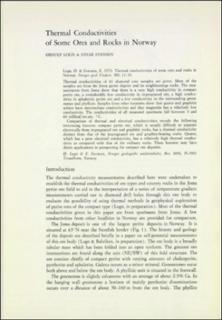| dc.contributor.author | Logn, Ørnulf | |
| dc.contributor.author | Evensen, Einar | |
| dc.coverage.spatial | 19241 Jomafjellet | |
| dc.coverage.spatial | DOVRE | |
| dc.coverage.spatial | 16232 Holden | |
| dc.coverage.spatial | 15193 Hjerkinn | |
| dc.coverage.spatial | KAUTOKEINO | |
| dc.coverage.spatial | RØYRVIK | |
| dc.coverage.spatial | INNLANDET | |
| dc.coverage.spatial | TROMS OG FINNMARK | |
| dc.coverage.spatial | TRØNDELAG | |
| dc.coverage.spatial | 18334 Mållejus | |
| dc.date.accessioned | 2020-08-26T13:11:44Z | |
| dc.date.available | 2020-08-26T13:11:44Z | |
| dc.date.issued | 1973 | |
| dc.identifier.uri | https://hdl.handle.net/11250/2674973 | |
| dc.description.abstract | Thermal conductivities of 61 diamond core smples are given. Most of the samples are from the Joma pyrite deposit and its neighbouring rocks. The measurements from Joma show that there is a very high conductivity in compact pyrite ore, a considerably low conductivity in impregnated ore, a high conductivity in sphaleritic pyrite ore and a low conductivity in the surrounding greenstones and phyllites. Samples from other locations show that quartz and graphitic schists have intermediate conductivities and that magnetite has a relatively low conductivity. The conductivities of all measured specimens fall between 3 and 0 millical\/cm.sec. C. Comparison of thermal and electrical conductivities reveals the following interesting features: compact pyrite ore, which is usually difficult to separate electrically from impregnated ore and graphitic rocks, has a thermal conductivity distinct from that of the impregnated ore and graphite-bearing rocks. Quartz, which has a poor electrical conductivity, has a relatively high thermal conductivity as compared with that of the ordinary rocks. These features may have direct applications in prospecting for compact ore deposits. | |
| dc.language.iso | eng | |
| dc.relation.ispartofseries | NGU (300) | |
| dc.rights | Navngivelse 4.0 Internasjonal | |
| dc.rights.uri | http://creativecommons.org/licenses/by/4.0/deed.no | |
| dc.subject | GEOLOGISK UNDERSØKELSE | |
| dc.subject | LEDNINGSEVNE | |
| dc.subject | METODE | |
| dc.subject | MINERAL | |
| dc.title | Thermal conductivities of some ores and rocks in Norway. | |
| dc.type | Journal article | |
| dc.description.localcode | 36300 | |
| dc.source.pagenumber | 11-19 | |

